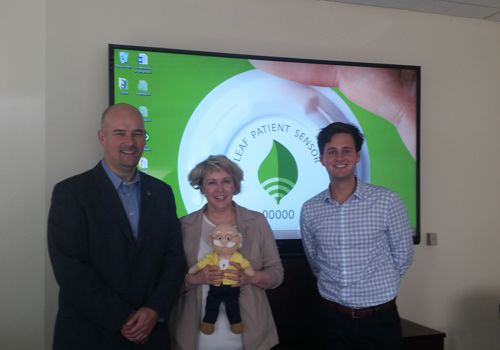Leaf Aims to Wirelessly Transform Healthcare
Leaf Aims to Wirelessly Transform Healthcare
Products Reduce Healthcare Costs and Preventable Deaths
A Hacienda startup is revolutionizing the healthcare industry with an innovative device that can drastically reduce costly and sometimes deadly bedsores.
Leaf Healthcare's patient monitoring system features a small wireless sensor worn by the patient, which wirelessly transmits crucial information to nurses or other healthcare workers about when a patient should be turned to avoid bedsores.
"We're an innovative company that is dedicated to managing and eliminating problems related to patients' immobility," Annemari Cooley, vice president of market development, explained. "When patients are immobile for longer periods of time, there are multiple things that will happen to your body. Number one is your skin will start breaking down. When your skin breaks down, you get pressure ulcers or what are also called bedsores."
While bedsores are painful for patients, they represent a huge financial drain for hospitals and other healthcare providers.
"Bedsores are the number one preventable problem in U.S. hospitals today," Cooley noted. "It costs our health system roughly $7 billion to $11 billion a year in avoidable healthcare costs."
The unobtrusive Leaf patient monitoring system is a breakthrough in preventing painful bedsores that can get infected and lead to death if left undetected.
Turning patients "is one of those basic nursing tasks that gets lost in the shuffle," Cooley said. "It's a task that does not get done and is contributing to this high incidence of pressure ulcers."
While all healthcare facilities have protocols, or rules, for how often patients must be turned, the average compliance rate is a mere 60 percent. When the Leaf system is used, compliance rates skyrocket to 98 percent.
"It has tremendous potential impact for reducing pressure ulcers and reducing extra healthcare costs," Cooley said.
A small wireless sensor is attached with a light adhesive to the upper part of a patient's torso. The sensor is waterproof, so patients can continue with their daily routines.
The sensor transmits information to a small antenna plugged into a regular wall outlet in the patient's room or the hallway. Information is then transmitted to monitors so that nurses or other healthcare workers can keep track of how frequently a patient is turned.
"It's very intuitive," she said. "Everything is displayed in red, yellow and green. There are no audible alerts to add to all the sounds already in a hospital."
Green means a patient is fine, while red means it is time to turn a patient. Yellow is a warning that it is almost time to turn the patient.
The Leaf patient monitoring system was developed by two Stanford medical students. One of their patients survived multiple burn injuries, only to die of bedsores she sustained while being treated.
"That was the impetus for these two students," Cooley said. "They built an initial prototype and got funding to make it into a real company."
Learn more about the company at leafhealthcare.com.
Photo: Leaf Healthcare CEO Mark Weckwerth, Vice President of Market Development Annemari Cooley and Co-Founder, Chief Medical Officer Dr. Barrett Larson
Also in this issue...
- Caltrans Office Puts Workers Near Construction
- Leaf Aims to Wirelessly Transform Healthcare
- Business Bits
- Hanson Gives Back in a Multitude of Ways
- Companies Flourish with Proper Legal Advice
- vRide Offers Simple Ride Share Solutions
- Hacienda - At Your Fingertips
- Kick Back & Enjoy Commuter Bus Over the Altamont
- Teens Helping Teens with 1Closet
- Teeing Up Success in Life Through Golf
- Hacienda Index
- Calendar





